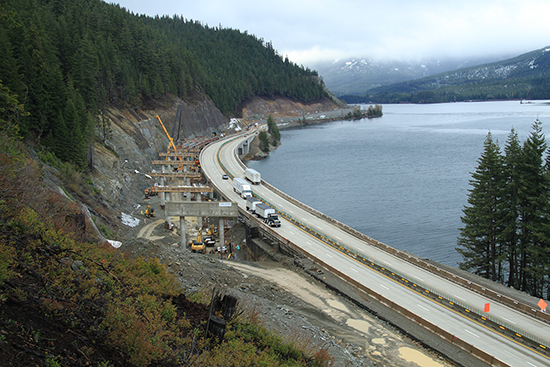|
Subscribe / Renew |
|
|
Contact Us |
|
| ► Subscribe to our Free Weekly Newsletter | |
| home | Welcome, sign in or click here to subscribe. | login |
Construction
| |
 |
January 22, 2019
Best in state: Gold award
Successful fulfillment of client/owner needs
Golder Associates

Project: I-90 Snoqualmie Pass snowshed replacement
Client: Washington State Department of Transportation/Jacobs
A half-mile stretch of Interstate 90 at Snoqualmie Pass required protection from the hillside, where falling rock was common and threatened the roadway.
Golder’s analysis of the Washington State Department of Transportation’s design of a snowshed replacement involving twin avalanche bridges resulted in changes to standard rock stabilization procedures. Golder challenged the state of practice and the project requirements by suggesting an approach that would create a safer passage for cars while reducing costs for the owner and accelerating the schedule.
As the project’s geotechnical consultant, Golder conducted a field investigation that confirmed unfavorable rock joint orientations at the site of construction that would make a safe stabilization very costly if the state of practice was implemented in the cut design.
The initial rock cut design indicated two inclinations: one at 76 degrees and the other at 50 degrees. With unfavorably oriented and weak rock joints, extensive rock reinforcement was initially required for the entire sector, even for the 50-degree cuts, to achieve the specified stability factors of safety under static and seismic loading. The extensive rock reinforcement requirements would have been very costly and caused construction delays.
Golder meticulously optimized the design, resulting in a cut inclination that differed from the state of practice. Its detailed stability analysis indicated that reducing the cut inclination from 76 to 65 degrees would significantly reduce the reinforcement requirements with only a slight increase in the volume of cut materials. Further interaction with the project team indicated that flattening the cut would also ease the construction operation. As such, Golder concluded that the state of practice using a 76-degree cut was not the appropriate approach for this project.
Furthermore, considering the unique site features and three-dimensional impacts of potentially unstable rock, Golder secured WSDOT’s approval to refine the project performance criteria. Coupling the revised cut design with the refinement of performance criteria resulted in substantial reduction in stabilization reinforcement.
Golder’s responsiveness to unforeseen rock conditions during construction was critical to the project’s success.
Other Stories:
- National finalist: Platinum award
Structural systems
Magnusson Klemencic Associates - Best in state: Gold award
Complexity
Reid Middleton - Best in state: Gold award
Unique or innovative applications
Stantec Consulting Services - Best in state: Gold award
Future value to engineering profession
Landau Associates - Best in state: Gold award
Successful fulfillment of client/owner needs
Cary Kopczynski & Co. - National finalist: Gold award
Transportation
WSP - National finalist: Gold award
Structural systems
HDR/Shannon & Wilson - National finalist: Gold award
Special projects
David Evans and Associates - National finalist: Gold award
Structural systems
BergerABAM - Engineer of the Year


